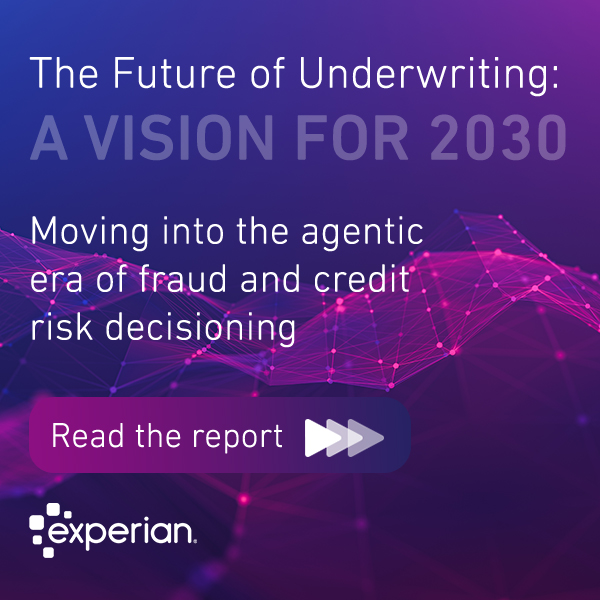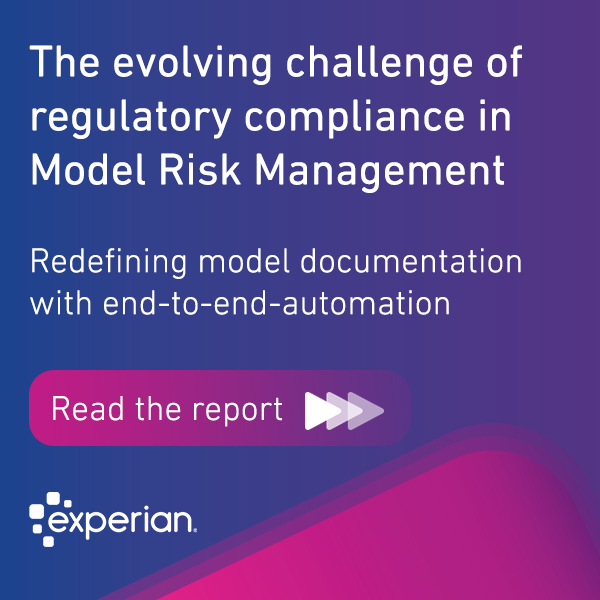Search Results for: ai

In this episode of Insights in Action, we talk about currently available technology used in machine learning, including APIs, SaaS and IaaS. Businesses of all sizes can leverage these methods to build the right cloud ecosystem and accelerate their AI operations. Experian Global Decision Analytics experts Mark Spiteri, SVP of Software Engineering, and Srikanth Geedipalli, SVP of Analytics & AI Products, share practical advice to help businesses identify core capabilities needed to get MLOps right. Get useful insights about: Ways for businesses to leverage AI and machine learning to drive greater impact and ultimately improve the lives of consumers How to use AI and advanced analytics to help manage your business in the current marketplace Setting business goals and strategic plans to operationalize and deploy your machine learning models at scale The 4Cs of a successful MLOps framework Real-life examples of businesses set for success with MLOps Listen now: Related stories: New Tech Talks Daily Podcast: Machine learning and AI in business — investment trends pre- and post-pandemic Impact of technology on changing business operations Game changers: Women in artificial intelligence

In this episode of Insights in Action, Mark Spiteri, SVP of Software Engineering, and Mariyan Dichev, Manager of Software Engineering, cover what it takes to build award-winning technology teams. They explore the dynamics of their work and how the ability to automate the decision-making process alongside the customer journey has become paramount in today’s dynamic environment. Mark and Mariyan walk us through their own transformational journey to enable organizations of all sizes to gain direct access to advanced tools and actionable insights. They give background on Experian Global Decision Analytics Technology Team winning AIBEST's Project of the Year 2020 Award in recognition of the strides they have made to enable quick, accurate, and effective credit decisions. Some of the topics discussed in this 20-minute podcast: Practical advice to get industry recognition for outstanding information technology processes and results. How to navigate the IT talent crisis successfully. What IT executives should look for when hiring for their teams. Tips on identifying the right fit: 3 types of people every award-winning engineering and software development team needs. How to manage and grow high-performing technology teams.

Explore these November headlines to stayin-the-know. Coverage includes forward-looking fraud prevention, International Fraud Awareness Week, and consumer and business research takeaways from our global experts. Fraud prevention strategies to prepare for the future Chris Ryan, Senior Fraud Solutions Consultant, provides tips on proactively combatting fraud risks to be positioned for success in a post-Covid-19 world — including categorizing fraud and using advanced analytics and technology to keep pace. #IFAW2020 Interview: David Britton, VP of Industry Solutions, Experian For International Fraud Awareness Week, David Britton, Vice President of Industry Solutions, speaks with Infosecurity Magazine about the current fraud landscape, common fraudster tactics, and best practices for preventing fraud. Only 30 seconds to impress — meeting APAC consumers’ online expectations Sisca Margaretta, Chief Marketing Officer for Experian Asia Pacific, explains why speed, seamlessness, and a thoughtful user experience are no longer nice-to-haves, but musts in today's environment. Pandemic entitlement: Consumers demand more online, Experian finds This MediaPost article explores business sentiment verse consumer expectations for their digital experience in the wake of Covid-19, with insights on how businesses can win from Steve Wagner, Global Managing Director of Decision Analytics. Are APAC banks equipped to help consumers in financial distress while juggling credit risk? Ben Elliot, CEO, Experian Asia Pacific, discusses the impact of Covid-19 on consumer financial wellbeing and spending power, and what the financial services and insurance industries can do to help those in financial distress while effectively managing credit risk. Stay in the know with our latest insights:

Fraud rates have held steady throughout the year despite the move to digital, but a few factors could change that this holiday season bringing greater losses than those of Christmas past. Globally, we’ve seen a spike in digital traffic as a result of Covid-19 the past 6-9 months, with some countries like Brazil reporting a 200% increase in digital traffic to retail sites. This means some physical fraud controls, like EMV or chip-and-pin, are no longer relevant. The number of data breaches this year compromised more than 36 billion records, eclipsing history’s reported record total. This means more legitimate credentials have been stolen, sold, and/or being used to commit fraud. On top of that, many businesses may be starting to loosen their online security restrictions in order to take full advantage of the topline revenue that comes with the influx of holiday traffic. This is especially true for those who’ve struggled to stay in business during Covid-19, who will look to increased holiday spending to offset declines earlier in the year. Unfortunately, fraud at the holidays is difficult to detect and there can often be a significant lag until fraud is realized, in some cases up to 3-6-months. So how do businesses protect themselves while providing a secure place for customers to shop online this year, especially during big events like Black Friday and Cyber Monday, while still offering a convenient digital experience? Businesses will need a layered approach to fraud management, and it starts by knowing what to expect. Holiday fraud trends to watch: Payment behavior: Most consumers will do all their holiday shopping online which means card-not-present payment fraud will likely spike, as fraudsters hide in the increased volume of traffic. With the shift from physical to digital transactions, traditional fraud controls, like EMV or chip-and-pin which are effective at minimizing card-present fraud, simply are not available to protect digital transactions. Average order value also tends to increase during the holiday season, requiring retailers to establish higher value thresholds for each order, to avoid flagging legitimate orders for review. Shipping behavior: Generally shipping behavior at the holidays is different than the rest of the year. People buy gifts and ship directly to the recipient, which means fraud detection logic that matches billing and shipping addresses to the legitimate cardholder may cause more false positives than fraud detection. Chargeback fraud: Holiday gift-giving pressure or loss of household income can sometimes lead to chargeback or friendly fraud, where a person may purchase an item – typically entertainment services or devices – use it and then return it, with or without intent to pay. Or in some cases, purchase an item, then issue a chargeback claiming no knowledge of the purchase. In-account fraud: Many retailers are now requiring a customer to set-up an account when making a purchase to identify their behavior and track purchase history. Like we’ve seen in the banking industry, fraudsters will use stolen login credentials to gain access to these legitimate accounts, make purchases using a card on file, and set up a secondary shipping address to re-route the items. Mule behavior: A newer form of fraud that’s gaining traction is where a legitimate customer is recruited to use either their shipping address or in some cases, their validated account to make a transaction using stolen payment information, receive the package, and forward to the fraudster’s address. Sadly, these fraudsters are known as “mule herders” are exploiting desperate, out of work people by recruiting them to work on their behalf. In the financial services space, victims may knowingly or unknowingly use their own bank accounts, to allow fraudsters to funnel money from other stolen accounts as part of an elaborate wire transfer or P2P payments fraud schemes. Phishing: The accelerated digital traffic during the holidays presents fraudsters a great opportunity to get consumers to click on all sorts of “offers” or fake merchant websites and steal personal information. This increase in phishing can take place across all known channels – email, phone, social, text, and web – and is a trend we’ve seen attack businesses and consumers alike. Unfortunately, fraudsters are appallingly impersonating health organizations, setting up fake cleaning and healthcare supply stores, Covid-19 statistic maps, and websites, all in an attempt to lure victims into divulging sensitive data. Who does fraud hurt the most? Online fraud during the holidays hurts many players in the transactional relationship – the legitimate customer, the merchant, and the bank or payment provider – but merchants tend to bear the biggest burden. This is best illustrated by the dispute process. When making a purchase, the main relationship is between the customer and the merchant. However, when a stolen credit card is used, or when a consumer has been a victim of account takeover fraud or some other fraudulent behavior, the person will dispute the charge directly with their bank or credit card company (card issuer). Card issuers and banks will either hold the charges back or reverse the financial transaction until a resolution can be met with the merchant. It then lies with the merchant to prove that the transaction was in fact legitimate, and to dispute that chargeback. The consequences of fraud for the merchant include multiple pain points: the cost of the stolen goods (and any shipping fees), the chargeback fee, potential fines by the merchant’s acquiring bank, and potential reputational challenges. Fraud prevention during the holidays The pandemic has already put an incredible amount of pressure on businesses and the rise in sophisticated fraud attacks may seem insurmountable. Creating a secure and convenient experience for your customers is possible and there are strategies and tools that can be implemented. Tools to layer into your fraud strategy: Require (and check) signatures upon postal delivery Offer immediate email confirmation and tracking number information Use a wide variety of digital and transactional data to make optimal risk/trust decisions Adopt dynamic risk strategies where controls can be adjusted to match the threat level Leverage machine learning models to access a variety of niche solutions or data sources for accuracy If 2020 taught us anything, it’s flexibility and resilience – two words that should describe your approach to fraud management this holiday season. The holidays can be a time of great joy, and this year most people are hoping the holidays will lift their spirits. Don’t let fraudsters dampen those holiday spirits! Related stories: New research available: The continued impact of Covid-19 on consumer behaviors and business strategies Better identifying your customers leads to greater trust How to get more from your existing credit risk and fraud risk technology

It’s not a surprise that we have seen an increase in digital activity during the pandemic. Lockdowns, store closures, various restrictions, and social distancing measures have led more people to the digital channel. In the months to come, it’s likely we’ll see more consumers adopt the digital channels as the world is going through a second wave of the COVID-19 pandemic. Many people have realized how convenient, safe, and fast it is to conduct their activities online. Our recent global research study shows some key numbers on how consumer behavior has changed over the past several months and what the expectations are for the months to come: Consumers are currently being driven more to use online activities, with 61% stating that they are ordering food or shopping for groceries online 36% of consumers conduct their personal banking activities online 34% purchase clothing, electronics, or beauty and wellness products online More than 2-in-5 consumers anticipate increased spending on items purchased online; both in the next 3-6 months (46%) and longer-term (45%) An increase in digital activity creates more opportunities for fraudsters The digital channel is here to stay, and more and more customers will be opening new accounts online as a result. This, however, creates some challenges for the institutions trying to onboard new customers as it also gives criminals many opportunities to legally enroll with an organization. The increased online activity raises the likelihood that fraudsters will be able to hide better inside genuine traffic. At the same time, it also presents them with a great chance to take advantage of synthetic identities that have been carefully put together over a long period of time and are harder to spot now that more activities are handled online. Furthermore, fraudsters are engaging in human farming attacks with the intent of impersonating their victims better and navigating through security measures that are set up to detect bots and automated attacks. This means that businesses need to make sure that they know who they are engaging with online: their customer or a fraudster. Pay close attention to how you handle consumer onboarding and customer authentication Identity verification is one key area that should be carefully considered by institutions and merchants. For a long time, it’s been perceived as a process that adds unnecessary friction and might drive customers away. However, new tools and capabilities have been introduced recently that make it a much smoother process. It not only reduces friction but it speeds up the onboarding of new customers through extracting data from identity documents and pre-filling registration forms. What might be even more exciting is that it can be combined with passive methodologies such as behavioral biometrics and device intelligence. Behavioral biometrics can help distinguish between normal and fraudulent activity at the sign-up stage, while device intelligence can be used to screen new customers for multiple fraud indicators. On top of that, businesses also need to continuously authenticate customers, in order to make sure that the person behind the screen is the same one that registered with them in the first place. Consumers will expect that any such interaction will be smooth and fast without unnecessary friction added to their online experience, such as re-entering the same personal information again and again. Nearly 30% of global consumers are only willing to wait up to 30 seconds before abandoning an online transaction and only 35% are willing to wait more than 1 minute, especially when accessing their bank accounts. More than half of consumers will abandon their basket if they are made to wait in the excess of 1 minute for online groceries 62% of consumers say biometrics enhances their experience and improves their opinion of a business Orchestration platforms could solve multiple problems So, on one side are criminals, who are always looking for system or process vulnerabilities and will not hesitate to exploit them, while on the other side consumers will be looking for a smooth online experience without any interruptions. This all means that account opening and continuous authentication (or re-authentication) should be looked at very seriously. 57% of businesses expect to increase their fraud management budgets in the next 6 months – this is highest in India (76%) followed by the U.S. (69%) – and supporting or upgrading their onboarding and screening capabilities is necessary. It’s likely, though, that organizations won't be able to solve these problems with a single solution which is why orchestration platforms are becoming so popular and valuable. These platforms offer multiple verification capabilities at the account opening stage as well as continuous authentication using device intelligence and behavioral biometrics, which is further enriched by a layer of advanced analytics, e.g. machine learning. So, while more than 30% of businesses are focused exclusively on activities to generate revenue (over fraud detection), we encourage prioritizing both during the pandemic so acquiring new, authentic customers online will lead to greater trust and lifetime value

The artificial intelligence (AI) market is expected to grow 159% by 2025 to $190.61 Billion, according to Markets and Markets, and there’s considerable value for businesses and consumers. In our July global survey of businesses and consumers, we found that 60% of businesses planned to invest in advanced analytics and AI to better support their customers' financial needs during Covid-19. As more businesses adopt AI, processing their vast amounts of data with advanced analytics for automated decisions, human oversight is and will remain key to ensure transparency and explainability. This “human element” in AI was the inspiration for our latest “game changers” series. We recently sat down with five industry experts to get their view on how AI is making the world a better place, and how its use in financial services can be realized. Yi He, Deeba Kazmi, Jennifer Kung, Kathleen Peters, and Laura Stoddart are visionaries and leaders in data science and innovation making a real difference in how advanced technologies are helping consumers and businesses engage more meaningfully. Q: What excites you most about the AI Industry? He: "As AI is more involved in our lives, it provides benefits we couldn’t imagine before – such as using your face to unlock your phone security. With the development of AI and machine learning, we can find patterns in data or in behaviors of people to solve complicated problems. That’s really it; helping people make life easier." Kazmi: "The main thing is that AI is not only transforming the way we live and communicate, it's changing the way almost every industry around the world is going to operate. To positively contribute to this growth, it’s not just that you need to learn and then deliver, but to keep innovating and coming up with new solutions that others learn from." Kung: "The technology improvement excites me. Things are getting easier, giving us more time to focus on what really matters. We usually don’t have time to focus on some of these areas because we are used to doing things manually. Now with AI, we have a machine to do a job that is manual, so we can focus on analysis and improvement." Peters: "What’s most exciting for me are ways AI technology can augment human decisions and innovation, in new directions that we historically run out of horsepower for. And, it can be applied to virtually every industry — the ways that it can better help us leverage big data, robotics, the Internet of Things — there are so many directions we can go with AI." Stoddart: "One of the most exciting things about AI is that people benefit from it every day — using social media, or maps to get to the shops, sometimes without even realizing it. And, if you can create an algorithm that can help somebody get credit who previously couldn't, you can have a real impact on the world that actually changes people's lives for the better." Q: What concerns you most about the AI industry? He: "I think the key things are data security and privacy protection. People are more and more sensitive about their information being used and released, which is understandable, and why opportunities exist to opt-out of information being used or sold to third parties. The key is to offer comfort by building in how to secure the data and protect privacy." Kazmi: "There are pros and cons of everything, especially with a stream of faster evolutions in prominent areas affecting our day-to-day lives. Since it’s still so innovative, when AI is introduced, there’s bound to be reluctance. But, to progress, we need acceptability, encouragement and patience; an understanding between AI research and stakeholders that these developments are going to bring huge positive change." Kung: "My main concern is that we need to keep in mind that AI is just a tool to help us. The machine will not replace humans and it cannot tell you what to do. An algorithm can give you a number based on its design. You need to analyze that result and ensure decisions make sense for your business." Peters: "The more we know and learn about AI, the better we can anticipate potential risk areas. These include the ethical aspects of technology, and striving to be consciously unbiased. As we progress, explainability and other model governance practices will help us stay within the right guardrails and mold the necessary regulations." Stoddart: "Lack of diversity concerns me – both in the boardroom and on the programming side. Decisions that we make in our programming are based on assumptions as human beings and our lived experience. If the people writing the code are not diverse, you’re missing out on whole groups of people in the wider society." Q: Can you share with us the “backstory” of how you decided to pursue this career path? He: "My educational background includes cognitive science, neuroscience, and psychology, and it involved a lot of data analysis and modeling. I wanted to understand how humans behave. In my first job, I did essentially the same work — understanding human behavior from large amounts of data — but to detect fraud. That amazed me and driving my focus today." Kazmi: "My education included subjects around analytics, and had a lot of flavor of data science, predictive modeling, mathematics and statistics. AI was very new at the time. I studied these topics and began to understand how data science is developing, and what's the future of it. I really got excited and interested into it. And once I started my career, there was no looking back." Kung: "As a child, I thought I wanted to be an engineer. Statistics was my second choice. But, I am really glad I had the opportunity to follow this path, because statistics and data analysis are amazing. When I started my course, I was so amazed at how data analysis can help you discover a world. You can do anything with data. I realized that this was my true passion." Peters: "I became interested in AI from the business aspects – working in a big data environment, we really needed machine learning and AI to handle data at scale. When joining Experian in the identity and fraud area, our mission was clear – harnessing the power of one of the largest data assets in the world to make a difference; finding new ways to stop fraud." Stoddart: "I studied physics at university and attained a master's in particle physics. But, during my final year, I started to learn about AI and machine learning. It was inspiring, especially how quickly they can have an impact on the world compared to academic research, which can be over many years. Realizing how quickly it was progressing, I thought it would be really exciting to get involved." Q: Can you tell our audience about the most interesting projects you’re working on now? He: "Recently, I’ve been working on use cases and projects surrounding identity. We have been working to link identity data from various sources – online and offline. Here at Experian, we have information from many sources, across different business areas. This project is providing a platform to link all this data together, which in the past was not very easy to accomplish. With this platform to provide linkages, it provides a 360-degree view of a person and helps provide conclusions such as whether two identities are the same person. To do this, we utilize machine learning techniques and AI. It’s very exciting." Kazmi: "I would like to mention something I'm very proud of, which has been a turning point in the way I look at data science solutions. I have the privilege of playing a prominent role in solving for a crucial economic and societal problem of the world, financial inclusion. This issue has historically blocked growth for financially weak and less established sections of society. I am leading data science as part of the initiative, exploring different sources of information beyond credit history, to increase access to financial products. This is the beauty of data science and how it helps us." Kung: "At Experian, I work in a consulting area, so I advise our customers and show them the power of data. Often, it’s not easy for a client to recognize this power. That’s our job – showing them how data can help their business or their decisions. We developed a credit decisioning model for one client using machine learning. This showed them how powerful it can be to use the data we make available to them. They were so amazed with the results. It was a really great experience." Peters: "The newest aspect of my role is leading innovation and strategy for decision analytics in North America. I am constantly on the watch for opportunities to incubate and try to apply Experian’s data and analytics and AI capabilities to solve new problems. We are looking at the role of identity and how we might apply capabilities in new ways. There is an expansion of needs, especially as the world evolves, and how we’re identified is evolving. So the application of Experian’s differentiated capabilities to new areas and markets is an area of focus of mine that I'm really excited about right now." Stoddart: "One of the most interesting projects I've worked on since joining the lab is around fairness of machine learning algorithms, decision-making. It’s about tackling the bias that can come when you use machine learning in a real world scenario. This happens when an algorithm is not being checked properly and it's discriminating against a certain group. To be part of building this vision about treating everybody fairly is great. Especially to be part of a company that values this effort and recognizes that it's going to be increasingly important going forward." Related stories: What is the right approach to AI and analytics for your business? Four fundamental considerations Maximizing impact from AI investment: 4 pillars of holistic AI Forbes: Are we comfortable with machines having the final say? Yi He Yi He works as a data scientist in the Experian NA DataLab. She is dedicated to using machine learning and AI to extract information from large amounts of data to identify, understand and help people, and prevent fraud. She aims to bridge online and offline worlds by linking identity data from these unique sources. With a focus on minimizing friction to customers, Yi’s work helps organizations identify synthetic identities to avoid fraudulent applications. Recently, she contributed to a Covid Outlook & Response Evaluator (CORE) Model – a “heat map” of geographic populations across the U.S. most susceptible to severe cases of Covid-19. Deeba Kazmi In her role as a data scientist at the Experian APAC DataLab, Deeba Kazmi is focused on solving business problems with analytics, including the development of consumer and small to medium enterprise credit risk models that leverage alternative data. Deeba is passionately focused on leveraging AI to create solutions that can help address issues faced by developing markets. Most prominently, this work includes her data science leadership contributions to solving a crucial economic and societal problem – financial inclusion. This effort is helping disadvantaged socio-economic consumer groups gain access to vital credit and financial services by leveraging the power of technology to deliver better outcomes. Jennifer Kung Jennifer Kung is an analytics consultant for Serasa Experian Decision Analytics, where she combines her knowledge of financial services with her data analysis expertise. Jennifer aims to harness the power of data through robust, descriptive and predictive analytical solutions to help clients realize the benefits of the massive amounts of data available to them. She recognizes the magnificence in powering discoveries through data analysis and enjoys revealing these capabilities to businesses who can benefit from these robust, yet approachable solutions. Jennifer enjoys knowing that her work helps to simplify and accelerate decisions that consumers rely on at important times in their life. Kathleen Peters Kathleen Peters leads innovation and business strategy for Decision Analytics in North America. As the prior Head of North America Fraud & Identity business, Kathleen is well-recognized as an identity industry innovator, being named a “Top 100 Influencer in Identity” by One World Identity the last two years. As of 2020, Kathleen was named Chief Innovation Officer for Decision Analytics. Kathleen and her team rely on the power of AI to continuously find new ways to solve customer challenges by defining product strategies, new paths to market and investment priorities. Underlying these efforts is a key focus on the ethical use of technology and the need to be consciously unbiased. Laura Stoddart Laura Stoddart is a physicist turned data scientist who works at the Experian DataLab in London. From her first exposure to AI, she recognized how quickly it can have an impact on the world, which has driven her to get and stay involved in the industry – both professionally and personally. Laura’s recent work has focused on ethical AI, having recently contributed to her first paper addressing the removal of bias from models. In addition, she is concentrated on leveraging emerging datasets to evaluate risk. Outside the DataLab, Laura also volunteers her data science skills to good causes such as Bankuet and helps expose others to the world of AI through mentoring.

In the not so distant past, consumers mostly interacted with their banks in person. Retail customers, for instance, waited in line to make a deposit or talk to a banker. And though the branch may have been busy, a moving line gave comfort to customers that the wait wouldn't be much longer. However, customer expectations in the digital era are dramatically different. According to Experian's new research, one in three customers will abandon a transaction if they have to wait more than 30 seconds, especially when accessing bank accounts. And that's just the tip of the iceberg. When it comes to the digital experience, consumers increasingly want seamless service at every point of their journey. Now, as the Covid-19 crisis continues to accelerate digital demand, financial institutions face more and more customers with similar if not greater expectations. Expectations for things like personalized products, contextual lending decisions, and offline-online seamlessness. And those organizations that understand these evolving needs and deploy cloud-based decision management to ensure they meet them will likely be the winners in this new world. Right here, right now Banking digital transformation was already underway before the pandemic began. Most retail banks provided some customer-facing app. In efforts to automate and streamline business processes, many organizations have also started to migrate their backend infrastructure from on-premise software to the cloud. The pandemic, though, ramped up the demand for everything digital seemingly overnight. Consider that consumer adoption of mobile wallets has jumped 11% since July, largely due to increased contactless in-payments. In the height of the crisis, customers turned to online platforms for financial assistance, from federal loans and grants to mortgage relief and credit applications to small business loans. Businesses that had already migrated to cloud-based solutions were able to scale their response to meet that growth. But that those hadn't? They faced the combined challenge of needing to scale existing services to serve the influx of online customers while simultaneously adding new digital capabilities. As a result, some organizations have ended up playing catch up with their digital offerings. Experian research shows, though, that it's a race worth finishing. Sixty percent of customers say they have higher expectations of their digital experience now than they did before the pandemic. To be sure, the crisis will end. Those expectations, however, are here to stay. A glimpse of the future Banks may see fewer customers in person, but that doesn't mean their service can't be personal. The data analytics features of cloud-based decision management software allow businesses to know more about their customers, providing personalized offers and services right when customers need them most. One bank we work with in India provides an ideal example. They've leveraged deep analytics and decisioning solutions to accelerate their online loan approval process from days down to seconds. They're no longer turning people away who are good candidates for loans. And they've increased their lending without having to take on additional risk. It's a win-win that reveals how organizations can leverage technology to satisfy customer expectations during the height of a crisis and continue to in a post-Covid reality. With cloud-based solutions, organizations can become 100% customer-centric, both in convenience and personalization. The data gives financial institutions a holistic view of their customers, enabling them to anticipate needs and tailor solutions to the individual. Transformation and soon No organization is going to digitally transform overnight. But given the urgency of the demand, there are proven ways to improve their digital customer experience sooner rather than later. Small-to-mid-sized organizations, for instance, should consider out-of-the-box Software-as-a-Service (SaaS) solutions. These offer pre-determined, high-demand use cases such as online eligibility checks and customer acquisition tools. Organizations can modify these solutions to meet specific market needs while saving time on ramping up a fully custom solution. Additionally, even with the imperative to meet the digital demand, it's important to remember that proper planning leads to successful cloud migrations. Consider all the possibilities of what could go wrong and right in terms of incident management, customer service, links to data sources, and more. Rehearse your transition as much as feasible. The preparation may add a bit of time on the front end, but you'll decrease the likelihood of significant disruption when you do migrate and that's worth the effort. The march toward an increasingly digital customer experience only moves in one direction: forward. The pandemic may have pushed financial institutions to speed up their transition to cloud-based decision management, perhaps a bit earlier than some anticipated. But the outcome of a proactive, data-driven organization centered on serving customers promises to be better for everyone. Related stories: New research available: The continued impact of Covid-19 on consumer behaviors and business strategies Automating fairness: Using analytics to help consumers in a pandemic era In digital transformation, small wins lead to big outcomes

For executives and teams across the financial services sector, the question isn't should we digitally transform—but how. That's where things get tricky. According to the Financial Brand’s Digital Banking Report, when asked about the progress of their digital transformation journey, only 17% of organizations reported that their transformation was deployed “at scale” — and a scant 7% said their transformation was deployed at scale and working. Tackling an enterprise-wide transformation effort is no small feat; it requires significant investment and time. Still, many organizations become understandably discouraged when transformation efforts don't yield the anticipated results. And experts contend that transformation initiatives fail not because of products but because organizations need wholesale culture changes to sustain innovation. All that may be true. However, a boil the ocean approach can dramatically increase the timeline of an already lengthy process. By building a strategy based on small iterative wins, businesses can break down the process and deliver interim tangible successes. In doing so, organizations sustain momentum for the broader digital transformation vision and benefit from feedback along the way. Your north star In concept, digital transformation suggests that we are in a finite time and place going from point A to point B. At some point, every financial institution will be digitally transformed. Manual processes, on-premise software, and siloed data will start to disappear. And conversations about transformation will give way to discussions of how to sustain and further advance the bank's digital capabilities. There actually isn’t a “finished state”, but a continuous progress towards a better customer experience. But establishing a long-term objective for transformation initiatives is critical. The leadership team needs to have a vision, and relay the overall goal to the rest of the organization. For instance, in the Financial Brand survey, banks and credit unions noted that improving risk management and security, improving the customer experience, and reducing costs were their top areas of focus. (Unfortunately, the same study revealed that less than half of the organizations surveyed reported high success levels in transforming these areas). In establishing a digital transformation north star, you ensure that smaller projects align with the broader vision. The path there may not be perfectly straight, but leaders can prioritize initiatives that point in the same direction. Small wins, big results As noted, it's challenging to complete a digital transformation journey in one fell swoop. Most organizations can't change technologically and culturally at a rapid pace. Yet, there's a pressing need for innovation. Creating a roadmap of incremental projects and wins can ensure your organization is making steady progress toward that north star goal. I often advise digital transformation teams to start with a small project that seems achievable. That may be transitioning a non-cloud offering to the cloud or introducing an existing interface to a new geography. You solve that problem, and then you evangelize the success; even if it's a small win, you want to shout about it. It's not about nourishing your ego. Instead, the celebration helps build momentum with your frontline staff and clients. It also provides proof points for executive stakeholders. The latter makes it easier to continue funding projects once your leadership sees that the initiative produces results. Then you can begin to expand your transformation perimeter, building on each win with another digital project. Dialing in your customer recognition and improving authentication, for instance, offers areas that are ripe for innovation—especially at a time when online transactions are on the rise and customer expectations are high. The right team for the job Successful digital transformation initiatives require leadership by a core team that's well-networked across the organization. They need to be highly visible to other teams and committed to promoting the cause and selling the vision, and making noise about any success because that's a core part of their job. Leveraging data and analytics along the way is also essential. Data can help you determine which problems to prioritize. And advanced analytics offers critical insights into what's working for customers and the areas that merit attention sooner rather than later. The process of digital transformation is an evolution. Organizations that view it as such should strive for strategies that deliver wins early. That way, they can build momentum, align near-term projects around long-term goals, and reap the rewards of digital transformation throughout the entire journey. Related stories: Impact of technology on changing business operations New global research: The impact of Covid-19 on consumer behaviors and business strategies Digital transformation through cloud-first decisioning

Several months into the global pandemic and we know that general indicators of risk or stress don’t reveal enough about what’s really going on within your customer portfolios. We also know that most institutions heavily use statistical models in identifying and capturing risk drivers in order to make decisions. Active model calibration in current circumstances can have a measurable effect on approvals and expected loss within a few weeks of being implemented. Banks have managed through economic recessions and other stressed scenarios by adjusting various levers for liquidity and risk. None, however, have ever had to predict consumer behavior in a pandemic. How can credit risk executives regain control over disrupted risk models at a time of constant change? Four key actions to enact now for immediate and sustainable impact: 1. Increase the frequency of model health monitoring Many of the predictive models that financial institutions rely on aren’t stable enough to handle real-world disruptions. Nor are the models re-calibrated frequently enough to appropriately assess risk in the rapidly changing situation we currently face. Monitoring models on a quarterly basis isn’t enough, but that tends to be the average frequency for most financial institutions. Increasing the frequency of model monitoring processes and identifying the need for a change in models sooner leads to significant financial impact. Depending on the asset size of the institution and the specific use case, financial institutions can potentially save millions of dollars in lost revenue or avoided credit losses. Automating the process supports an increased frequency of monitoring while requiring less effort from your analytics team. 2. Carry out ex-ante stress testing for your models Businesses should consider using ex-ante stress testing, in light of the difficulty in maintaining the accuracy of model predictions in changing conditions as well as to meet the heavy governance requirements of new models before their actual use. Traditional ex-post processes are effective in simulating what would have happened historically had a new model been in place. This is an extremely valuable exercise but isn’t very helpful in the current stress environment which is both unique and highly uncertain. Risk managers would like to have a go-forward view on model performance for decisions being made right now, not just a look-back view on decisions made historically. Applying ex-ante stress testing allows us to simulate and analyze a range of possible outcomes based on changing macro conditions, evolving consumer behaviors, and other uncertainties like the quality of underlying data. 3. Make practical, short-term adjustments We’ve seen in previous economic downturns that models can rapidly become unfit for purpose, and the consequences may not be fully apparent until long after the start of the downturn. In such circumstances, you shouldn’t necessarily attempt to make changes that you expect to be robust for many months into the future. There’s a strong case for making adjustments that are designed to address temporary circumstances and reviewing them at an increased frequency. Some businesses are taking a conservative strategy by tightening their credit policies and decisioning strategies. Other businesses are overlaying their models with certain attributes. For example, one could look at the number of open inquiries in the past 30 days. Since we know that attribute is unstable, we can pair it with an attribute that will give you more population stability – such as average open inquiries over the past 6 months. 4. Setup for rapid re-calibration or re-build of models The decision to re-calibrate or re-build a model during the pandemic would depend on multiple factors including the business need and model use case, the performance of the existing model, and the confidence in the quality and relevance of data for the model build. However, it is important that financial institutions and other businesses are set up to rapidly update their models. They should be actively working on re-calibrating/re-building their models in a test environment, evaluate the impact, and be prepared to deploy. The ability to rapidly update models will be a key differentiator as businesses compete to grow their portfolios and manage losses during and in the aftermath of this pandemic. As with many other aspects of our lives, credit risk management is being challenged by the new reality created by a global pandemic. Whether our response is temporary, or whether the crisis is accelerating an existing trend to be more active in model management, we need to react to maximize our portfolio performance. At the end of the day, none of us have been through a pandemic but we know our models can still work. It’s all about model accuracy and model governance and reducing error rates. By increasing the frequency and efficiency of model monitoring and re-calibration, we can drive business outcomes with more impact than ever before. Learn more: For many organizations, navigating and recovering from these volatile times will remain top priorities as they begin strategizing for the future. Get details on accelerating your digital transformation.

The Covid-19 crisis has been a bit like existing inside a shaken snow globe—it disrupted everything, and a lot remains up in the air. However, amidst the uncertainty of the pandemic, one thing has become evident: Cultivating customer trust is more critical than ever. Trust naturally generates loyalty. This is especially true during and after a crisis. For example, Experian's latest global research from July 2020 shows 52% of customers who felt that businesses treated them fairly during the pandemic plan to give those companies more of their business. That fairness bred trust and that trust will undoubtedly lead to more business. As consumers continue to increase their digital transactions, companies need to work hard to enhance customer trust. Improved identity authentication and recognition, for example, will play a key role. As everything begins to settle, those that succeed will find their business on far more steady ground. Does trust even matter? It's a good question—and the answer may be evolving in real-time. Consider that in 2019, Experian's global identity & fraud study showed that digital adoption did not indicate consumer trust of the business. "Consumers still adopt digital channels despite being highly skeptical of the businesses," the study noted. Social media provides an excellent example. Overall, most consumers distrust many of the popular social media platforms, yet they continue to use them regularly. Interestingly, widespread adoption is linked more to convenience than trust. However, this comes with a real caveat: Customers are less concerned about trust when the product is more frivolous. For instance, not trusting a media outlet or social media platform is very different from not trusting a financial institution. Also, a lack of adoption doesn't always mean that customers don't trust the business. In the financial service and payments realm, low adoption may simply reflect that customers use the platforms less regularly. Now, as consumers increase their reliance on online services, maintaining trust will be paramount. For instance, since Coronavirus began, consumers have increased their use and awareness of mobile wallets by 8%, and their use of retail payment apps by 6%. Balancing the convenience that people have needed with the necessary trust will go a long way towards keeping usage high once the crisis subsides. A virtuous cycle Within any digital experience, several components inform customer trust. You want to ensure accurate customer recognition, as well as transparency with your authentication. Robust fraud protection and positive digital experiences also play essential roles. These form the Cycle of Trust, a virtuous circle that ultimately encourages customers to share more information with your company and pursue more transactions. Our 2019 study reveals the importance of each part of this cycle, and we see it playing out now. For example, 90% of consumers are willing to participate in a more thorough identity verification process early on to have easier account access in the future. The ability to routinely and accurately recognize your customers helps build their trust in your technology and products. Also, 76% of customers have more confidence in companies that use biometrics over passwords to protect their information. That means that you can use advanced authentication strategies to enhance trust even more. Transparency also comes into play. Letting people know how you're using their information and whom you're sharing it with makes them more apt to trust your organization—and continue to share their data. The future of trust This cycle represents the goal. In practice, though, there are still quite a few challenges that prevent organizations from getting that wheel spinning. For instance, many have separated the risk assessment processes of verifying customers at signup, logging in, and transacting, so there's no seamless experience. Instead, customers navigate different solutions to onboard, authenticate their identity, and complete transactions. A company may recognize a customer at one point in the process, but not all the way through. What's more, organizations often still place the onus on the consumer for how they represent themselves in the digital world. Authentication processes require them to remember passwords or retrieve codes from their phone. But as noted, the pandemic has opened an opportunity for dramatic improvement. Consumers are at a rare moment in which they're open to change—and they're even looking for it. For example, since the beginning of the pandemic, 60% of customers say they have higher expectations for online experiences. More than half of customers are also more willing to provide organizations they trust with personal information and financial data. Finally, 44% of customers note that since Covid, they are more trusting of companies that demonstrate security. So how can you increase trust while also meeting evolving customer expectations? Organizations that pave the way will likely assume more responsibility for recognizing and authenticating customers. This starts with becoming more creative in using the data they already have access to recognize and authenticate customers. Extending this passive and continuous recognition across channels will also be necessary. Doing so connects the disparate processes and creates a more seamless digital experience. Such initiatives also remove the identity burden from the customer and kickstart that virtuous cycle. No one anticipated the Covid-19 crisis. But it's opened up the chance to create fairer, more trusting, more transparent digital experiences for everyone—and companies shouldn't pass that up. Related stories: Latest global research: The impact of Covid-19 on consumer behaviors and business strategies Better identifying your customers leads to greater trust Covid-19 as a Gateway to Fraud: Top 5 Global Fraud Trends to Watch Out for in 2020 Podcast: Securing online identity

In case you’ve missed these September headlines, we’ve compiled the top global news you need to stay in-the-know on the latest hot topics and insights from our experts. Transforming analytics into business impact CIO.com shares insight on using analytics to maximize business outcomes from IT leaders, including Shri Santhanam, Executive Vice President and General Manager of Global Analytics and AI. Global shudder: How businesses and customers are reacting to Covid-19 This MediaPost article covers global research findings on the impact of the Covid-19 pandemic, as well as perspective on the trends and what’s to come, from Steve Wagner, Global Managing Director of Decision Analytics. Experian touts Biocatch behavioral biometrics, adds Onfido face authentication for onboarding Biometric Update shares the latest on enhanced fraud detection for new account openings through a layered approach. Marika Vilen, SVP Platform Commercialization, Global Identity and Fraud, speaks to optimizing operations in today’s environment. Experian’s cloud-based solutions adapt to today’s evolving customer needs In this AiThority article covering cloud-based solutions for automating decisions, Donna DePasquale, General Manager, Executive Vice President of Global Decisioning, shares her perspective on businesses meeting the needs of today’s changing market. Why businesses need to meet the challenge of digital acceleration Steve Pulley, Managing Director of Data Analytics, offers global insights on continuing operations through an evolving digital marketplace impacted by Covid-19 in this Bdaily, United Kingdom, article. Stay in the know with our latest insights:





